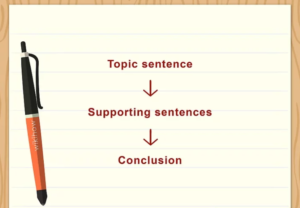IELTSのライティング試験は、タスク1とタスク2に分かれており、アカデミック試験では、タスク1は分析リポート、タスク2はエッセイライティングが求められます。
ライティングセクションは、構成や文法だけでなく、論理的な内容も解答に求められるため、解き慣れていないと、特に点数が取りづらいと言われています。
この記事では、タスク1とタスク2で高得点を実証する解答例と、便利な表現を紹介します。
IELTSライティング学習のコツ
ライティング試験でスコアアップが難しい理由は、タスク1、タスク2ともに解答の自由度が高いことが原因です。
解答のコツや具体的な対策方法が不透明であり、練習を重ねても点数が伸びないことも多々あります。
まずはライティングの評価基準を知り、実際に高得点を取得している解答例を参考にしながら構成や表現方法を学びましょう。
解答例や評価基準と照らし合わせることで、自分の解答を客観的に評価できます。また、構成や表現の仕方、段落の論理的な展開などの学習にもなりますので、積極的に活用しましょう。
IELTSライティング評価基準
IELTSライティングの採点基準は次の4項目です。
- Task Achievement:質問にきちんと答えているか
- Coherence and Cohesion:論理的であるか
- Lexical Resources:語彙
- Grammatical Range and Accuracy:文法の複雑さと正確性
それぞれが25%づつ配分されており、評価基準はタスク1、タスク2ともに共通です。
ライティング6.0の評価基準
IELTSライティングにおける日本人の平均点は5.7のため、目標としてスコア6.0を目指す方が多いです。
以下の表が、ライティング6.0の評価基準です。6.0が目標の方は、この条件を満たすように意識しましょう。
| トピック完成度 | 首尾一貫性 | 単語 | 文法 | |
|---|---|---|---|---|
| 定義 | – addresses all parts of the task although some parts may be more fully covered than others – presents a relevant position although the conclusions may become unclear or repetitive – presents relevant main ideas but some may be inadequately developed / unclear | – arranges information and ideas coherently and there is a clear overall progression – uses cohesive devices effectively, but cohesion within and /or between sentences may be faulty or mechanical – may not always use referencing clearly or appropriately – uses paragraphing, but not always logically | – uses an adequate range of vocabulary for the task – attempts to use less common vocabulary but with some inaccuracy – makes some errors in spelling and/or word formation, but they do not impede communication | – uses a mix of simple and complex sentence forms – makes some errors in grammar and punctuation but they rarely reduce communication |
| 日本語訳 | – すべてのポイントがカバーされている が、 偏りがある – トピックに関連する意見を述べること ができるが、結論がはっきりしない、 もしくは繰返しが多いことがある – トピックに関連する考察を述べること ができるが、詳細が十分でない、もし くははっきりしないことがある | – 情報や考察を一貫して述べることができ、 論理的な順番になっている – 文章を繋げる表現を効果的に使っている が、間違いもしくは不自然なことがある – 具体例を持ってくるのが正しくない、 もしくははっきりしないことがある – パラフレーズを使っているが、正しくない ことがある | – トピックに適切な単語を使っている – アカデミックな単語を使おうとしているが正しくないことがある – スペルミス、語の並びに間違いがあるが意味は伝えられる | – 基本および複雑な文法を使っている – 文法と句読点で間違いがあるが意味は伝えられる |
スコア6.0の基準をクリアした後は6.5の評価基準を確認し、条件を満たせるよう演習します。これを繰り返すことで、高得点につながります。
評価基準の確認は、ライティングの対策を行う上で、非常に大事な指針となります。
バンドスコア6.5~7.0を獲得する条件
ライティングセクションで高得点と言われる、スコア6.5~7.0を獲得するには、8つの条件を満たす必要があります。
- すべてのポイントがカバーされている
- 文法のミスがあまり見受けられない
- 自分の主張が明確に述べられており、しっかりと裏付けされている
- リンキングワードや接続詞を適切に使えている
- 論理的に話が展開されていて、内容にまとまりがある
- 少々の間違いがあるが、アカデミックな語彙を十分に取り入れている
- 複合文や重複文が使用されている
- 分野別用語を使用しており(Topic-specific words)、曖昧な表現が少ない(things, matters, good, stuff)
複合文とは、when/if/although/whileなどの従属節を伴う文
重複文とは、複合文がand やbutなどでつながっている文のことです
8つの条件を満たし、高得点を狙うための学習のポイントを紹介します。焦らず、コツコツ演習を重ねましょう。
文法のミスは減点対象になるため、まずは文法の間違いをなくしていきましょう
アカデミック用語を用いた長い文章を書けるように練習していきましょう
解答を考える際に、自分の意見はいったん脇に置きましょう。偏見を取り除き、事実に着目して解答を構築することで、論理性が高まります。
抽象的な言葉を使用して表現するのではなく、言葉を具体化しましょう。具体的に「何をどうするか」を、順序立てて説明することで、論理的思考を鍛えられ、スコアアップにもつながります。
学習の注意点
最近では、たくさんのIELTS対策サイトがあり、モデルアンサーも多く紹介されています。
オンラインで紹介されている解答例を参考にする際は、信頼できる情報かどうかに注意しましょう。
学習の際は、誰が書いた解答か、高得点を実証してるか、文法の間違いがないか、などに注意しましょう。
IELTS ライティング解答例<タスク1>
ライティングのタスク1では、数字を入れた統計リポートを、20分以内に150文字で仕上げることが求められます。
ここでは、3つの出題形式と、それぞれのモデルアンサー、タスク1で使える表現を取り上げます。
出題形式と解答の構成
出題形式
IELTSアカデミックライティングのタスク1では、以下の3パターンのいずれかが出題されます。
- 図表の説明
- 地図問題
- プロセスマップ
このうち、図表の分析が最も出題頻度が高い問題です。棒グラフ、円グラフ、折れ線グラフや表が出題されます。
表やグラフは、問題に1つだけ示される場合もあれば、2つや3つが示される場合もあります。
与えられた情報が多い場合は、それぞれの表の関連性を見つけ、2つまたは3つの特徴をまとめることが求められます。
解答の構成
ライティングで高得点を獲得するためには、きちんとした構造(ストラクチャー)が重要です。
タスク1では、解答は以下の4段落構成で構築しましょう。
- イントロ(問題文の書き換え)
- 概要(目立つ特徴を述べる)
- 詳細1(数字を必ず入れる)
- 詳細2(比較級を使う)
解答を家に例えるなら、ストラクチャーはその骨組み(柱や壁など)にあたります。構造がしっかりしていれば、解答も一貫性があり、まとまりのあるものになります。
例題① Line Chart
Line Chart(折れ線グラフ)では、変動の大きい線や、全体としてどう推移しているかに注目して特徴をまとめます。
The graph compare employment rates in three sectors of the economy, in the UK, 2000-2010.
Summarize the information by selecting and reporting the main features, and make comparisons where relevant.


解答例
1.イントロ(問題文の書き換え)
The graph gives information about the percentage of people who were employed in three different areas of the economy in the UK, over a ten-year period starting in 2000.
2. 概要(目立つ特徴を述べる)
Overall, there was a significant downward trend in the percentage of people employed in the private sector, while the figures for the public sector and self-employed people shows a similar upward trend.
3.詳細1(数値を必ず入れる)
In more details of the private sector, the percentage started at just under 50% in 2000, and then there was a steady fall to about 28% in 2008. Having fallen sharply to roughly 21% in the following year, the percentage then levelled off at the end of the given years.
4.詳細2(数値を必ず入れる)
If we look at the rest of the statistical data, the percentage of self-employed people began at around 18% in 2000, which was the lowest proportion of the three sectors. There was a slight dip between 2002 and 2005, after which the percentage rose steadily year on year , finishing at 30%. The figure in the public sector, in the contrast, remained stable at 38% in the first three years of the decade, but then there was a marked rise to 48% in 2004. Despite going down slightly in 2006, a gradual increase can be observed and the proportion hit a peak of over 50% in 2010.
(215 words)
重要表現
- give information on:show や illustrate の書き換え表現として有効です。
- there is a downward trend an upward trend:「下落傾向がある(上昇傾向にある)」という表現で、全体的に下がり気味(上がり気味)の棒線グラフに使える便利な表現です。
- start at A:Aから始まるという表現です。後ろに数字を置くことができ、start at 50%「50%から始まる」のように使えます。
- having fallen sharply to:こちらは分詞構文を使った表現に完了形を用いています。「~してしまった後」という意味ですが、主語が後ろの文と一致しているため、主語が抜けて、最初の動詞をing形にします。
- level off (level out):「横ばいになる」という意味で使用します。
- at the end of the given years:取り上げられている年の終わりごろにという表現で、具体的な年号を言及せずに表現することができます。
- if we look at A:「Aを見てみると」という表現は段落の始めに使うと便利です。
- A, after which B:関係代名詞を使った非限定表現で、「Aの後B」という意味になります。
- year on year:副詞もしくは形容詞として使用でき、「前年(同期)比で」という意味になります。
- remain stable:「安定した状態を保っている」という表現で、数値があまり変わらない時に使用できます。
- A can be observed (A can be seen):「Aと見受けられる」「Aと観察しうる」という表現です。Aには無生物主語が入り、例えば ”decrease can be seen”「下落がみられる」のように使用できます。
- hit a peak:「ピーク(頂点)に達する」という表現で、グラフで一番高い点を説明する時に使います。
task1の導入文の書き方
- The line graph illustrate
- The table gives information on
- The pie chart compares
- The bar graph provide date on
図表の説明に使える便利な表現
- account for 50% (50%を占める)
- make up 10% (10%を占める)
- compared to A (Aと比較して)
- followed by A (Aがその後に来る)
- reach the low of (最低値に達する)
- reach the high of (最高値に達する)
図表の説明の注意点
- 書き換え(パラフレーズ)を必ず行う
- 時制に気をつける(過去形・現在形・現在完了・予想未来)
- 複数の図表がある時はすべてについて言及する
- 主な特徴をまとめる
- 数値を入れて表現する
例題② プロセスマップ
プロセスマップでは、何かの工程が示された図について、適切な表現を使いながら、手順を順番に説明します。
「要約をする」というよりも、「順序よく説明する」ことがプロセスマップでは求められます。
The diagram below shows how tomato ketchup is made commercially.
Summarize the information by selecting and reporting the main features, and make comparisons where relevant.


解答例
1.イントロ(問題文の書き換え)
The given pictures demonstrate the way of making tomato ketchup step by step.
2. 概要(目立つ特徴を述べる)
Overall, there are 15 phases in the process to manufacture a bottle of ketchup.
3.詳細1(ステップバイステップで説明)
First of all, tomatoes are picked up from a farm and put in baskets. Then, only good tomatoes are selected from the ones that have been picked. After being sent to a factory, the tomatoes will have a removal process in order to get rid of stalks, seeds, skins. Having been collected into containers, the processed tomatoes are crushed and turned into liquid. Following this process, sugar, salt and vinegar are added to be boiled together.
4.詳細2(残りのステップの説明)
After being left for two hours, the tomato liquid is poured into tomato ketchup bottles and labelled as polished products. The next step is, to ensure the product quality, inspectors check all their products and only the selected bottles are packed and delivered to supermarkets. Finally, the customers enjoy the tomato ketchup with the foods of their choice.
(160 words)
重要表現
プロセスマップではトランジション・ワード(転換語)が重要!
- first of all:「まずは始めに」と、最初の手順を促す用語です。
- then:「それから」という次の手順を表す言葉ですが、いろんな箇所に使っていくことが出来ます。使い過ぎに注意しましょう。
- after being +過去分詞:「~された後」という受動態です。主語を抜かしている理由は、後ろの文の主語と一致しているからです。接続詞の後に動詞を直接持ってくる場合は、動詞を必ず ing 形にします。
- having been +過去分詞形:図表の解析でも取り上げた分詞構文を使用した表現です。完了形を用いて「~した後」という意味になります。
- following this process:”then” などの代わりとして使うことができ、「このプロセスに続いて(このプロセスの後)」という意味を表します。
- the next step is:「次のステップは」という転換語です。
- finally:「最終的に」「やっと」という重要な転換語です。プロセスの最後に使用します。
例題③ 地図問題
地図問題では、都市(町、公園、道)の移り変わりを表す図が、2つもしくは3つ提示されます。
図から読み取れる変化について記述しますが、全てを書く必要はないので、目立つものからピックアップしましょう。
The pictures illustrate the changes in Shipsmouth between 1995 and 2010.
Summarize the information by selecting and reporting the main features, and make comparisons where relevant.


解答例
1.イントロ(問題文の書き換え)
The diagrams show the changes which took place in the city of Shipsmouth between 1995 and 2010.
2. 概要(目立つ特徴を述べる)
In general, it is clear that in 1995, the city was quite green and peaceful, but by 2010, it had become much more modern and busier, with new shopping and transport facilities.
3.詳細1(特徴的な変化を述べる)
One interesting change is that the trees in the north-west of the city were cut down to make way for new apartment blocks. Similarly, the woodland in the south-east of the city was cleared, and an airport was constructed in its place. Another striking development is that a new station was built to the north of the city centre and the railway line was extended to the north as well.
4.詳細2(残りの特徴的な変化を述べる)
If we look at the city centre, by 2010, the main road running through it had been pedestrianized. It is also interesting to note that in the west of the city, there used to be several factories, but these were demolished and replaced by a new shopping centre. Further developments were the building of new skyscrapers in the east of the city, and the construction of a football stadium in the south.
(191 words)
重要表現
- one interesting change is that:「1つの興味深い変化は….」という意味で、第3段落の最初に用いるといいでしょう。
- make way for A:「Aために更地にする」という表現で、A (新しい建物)のために何かが取り壊された時に用います。
- another striking development is that:他の特徴を表す時に用いて、「別の目立った発展は」という意味を表します。
- if we look at A:第3段落もしくは第4段落の初めに使用して、「Aを見てみると」という意味になります。”If we look at the North of the town, “のように方角を示す言葉とともに使用することができます。
- it is also interesting to note that:「別の興味深いことには〔that以下〕である」という表現で、“Another striking development is that” と同じように使用することができます。
- there used to be A:「A はかつて存在した」という表現で、新しいものに取って代わられる前の建物の存在を言及する時に使用します。
IELTS ライティング解答例<タスク2>
ライティングのタスク2では、40分以内に250文字のエッセイを書くことが求められます。
最近の社会問題などが課題に挙がることが多く、解答はタスク1と同様に、次の4段落構成で記述します。
| 段落 | 段落の内容 | 解答のコツ |
|---|---|---|
| 第1段落 | イントロダクション | 定型文をできる限り使用し、時間と労力をかけない |
| 第2段落 | ボディー1 | 時間と労力を使い、試験官にアピール |
| 第3段落 | ボディー2 | 時間と労力を使い、試験官にアピール |
| 第4段落 | 結論・まとめ | 定型文をできる限り使用し、時間と労力をかけない |
IELTSライティングのタスク2で出題されるエッセイは、下記の5つのタイプに分かれます。
- Discussion エッセイ(advantage disadvantage エッセイ)
- Opinion エッセイ
- Discussion opinion エッセイ
- Direct Question エッセイ
- Cause and Solution エッセイ
今回は、出題頻度の高い「Discussion Opinionエッセイ」と、「Direct Questionエッセイ」の解答例を紹介します。
どのエッセイタイプでも、解答は4段落構成で作成しますが、設問タイプ別に書き方が変わります。詳しくは以下の記事で紹介しているので、ぜひ参照してください。


例題① Discussion Opinionエッセイ
「Disucussion/Opinion essay」は、アカデミックでよく出題される、重要なエッセイタイプです。
自分の意見述べつつ、対立する意見も肯定する必要があり、公平かつ客観的に物事を判別する力が問われます。
高得点実証サンプルを参照して、アカデミックワードの使い方、論理的な構成、話の展開や効果的な接続詞の使い方も確認してみましょう。
Some people believe that there should be fixed punishments for each crime. Others, however, argue that the circumstances of an individual crime, and the motivation for committing it, should always be taken into account when deciding on the punishment.
Discuss both these views and give your own opinion.
解答例
1. イントロ(問題文の言いかえ&エッセイのプラン)
Although there is no doubt that crime must be punished, it is important to consider which type of penal system is most appropriate. While some believe that a system of fixed sentences would be adopted, I support the view that punishments should be based on motives and circumstances.
2. ボディー1(自分と対立する意見を肯定)
Those who advocate implementing a judicial process of set punishments may argue that this would make criminal trials more efficient. For example, once a jury has decided a particular defendant is guilty of murder, the judge need only refer to the ‘punishment for murder’ to sentence that person to life imprisonment. The benefit of this is that a huge amount of time would be saved in court, thus leading to significant financial savings. As a result, more money could be spent on healthcare, education and welfare.
3. ボディー2(自分の意見)
However, I would argue that the above system is too rigid, and a process of ‘flexible’ punishments is much fairer. The latter punishment system, which many countries use, leaves more room for compassion toward offenders who have been blackmailed or manipulated. For instance, under this system, if a thief is able to prove that he had been bullied into committing his crime, he should be sentenced to less prison time than a thief who had been motivated by greed. If, instead, fixed punishments were implemented, this sense of fairness and morality would be lost.
4.結論(ボディー1と2のまとめ)
In conclusion, although a legal system of fixed punishments might be more cost-effective and efficient, I believe that a procedure of assessing crimes based on circumstances and motives is more just, and justice, in my view, is paramount.
(266 words)
重要表現
- There is no doubt that:「~は疑いない」という意味で、エッセイの書き出しで事実を述べる時に役立ちます。
- It is important to consider:「~を考慮することは大事なことです」という表現で、課題に対してのある一方の意見を提示する時に役立つ表現です。
- those who adovace …:「…な人は」という関係代名詞を使用した文なので、自然と高度な文法構造の文章に仕上がります。
- as a result:「その結果」というたわいもない表現ですが、論理的に物事を発展させた結果を表すための重要な副詞表現です。
- if, instead, …:「もし、逆に~なら」という仮定法を用いた表現。具体的に物事を展開させるための重要な表現です。
注意点
必ずしも長いエッセイが高いスコアにつながるわけではありません。評価基準にも、文字数についての言及は一切ありません。
IELTSでは、簡潔で分かりやすいエッセイが好まれるため、長すぎるエッセイは避けましょう。
例題➁ Direct Question エッセイ
In some countries, owning a home rather than renting one is very important for people.
Why might this be the case?
Do you think this is a positive or negative situation?
解答例
1. イントロ(問題文の言いかえ&エッセイのプラン)
People in some countries now consider owning a home to be more important than renting one. This essay will discuss the underlying reasons for this preference and elaborate on why it is a negative development.
2. ボディー1(トピックに対する答え1)
There are several reasons for people’s preference for home ownership. First, owning a house or an apartment means that they do not have to waste time on accommodation hunting when a rental contract expires. Therefore, they can just focus on their career goals or other important things, such as marriage. Furthermore, many people nowadays buy a home with a mortgage, and so they know the exact amount of money they owe and also the fixed amount they have to pay monthly. This allows people to make a clear long-term financial plan for the future.
3. ボディー2(トピックに対する答え2)
However, the trend that many people value home ownership over rented accommodation is negative due to the following reasons. While a tenant can easily terminate a rental contract and find a new place if they are not satisfied with their current accommodation, it is very difficult for home owners to do the same. In other words, once a person makes an unwise decision and buys a home that they later regret, they are usually left with only two options: either make the home available for rent or accept living in a place they are not happy with.
4.結論(ボディー1と2のまとめ)
In conclusion, people in some countries now prefer to buy their home because they value stability that owning a home provides and want to have clear future plans. However, unless thorough considerations are made, home owners may have to face undesirable outcomes from such a decision.
重要表現
- This essay will discuss:「このエッセイは….について議論します。」という意味で、エッセイのプランについてイントロで述べる時に役立ちます。
- There are several reasons for:「の理由はいくつかある」という表現で、ボディーで理由を言う時の書き出しとして便利です。
- due to the following reasons:「以下の理由で」という意味ですのでこちらも理由を後ろに羅列したい時の表現です。
- in other words:「言い換えると」という意味で、論理的な発展上、具体的に言い換える時に使えます。
解答のポイント
解答の構成がしっかりとしていれば、5.5-6.0ほどのスコアが取得できますが、さらに高得点を目指す場合は、次のポイントに注目しましょう。
- 考えに対する理由が論理的である
- それぞれの段落が論理的に発展している
IELTSライティングでは、内容も評価基準に含まれるため、「内容はなんでもいい」ということは絶対にありません。
試験対策として、さまざまな社会問題を熟知できるようニュースなどを読み、事実や一般論を学びましょう。
タスク2の便利な表現(イントロダクション)
- Many people are talking about
- There is an argument that
- There is a common consensus that
- Although some people think that
- It is true that
- In some communities,
- In recent times(Recently),
解答の注意点
- 問題文で問われていることをしっかりと把握して要領を得たエッセイにする
- 最近の社会問題に精通して一般論を学ぶ
- 書きすぎに注意
- 4段落構成で書く
- 文法ミスやスペルミスなどのケアレスミスをなくす
以下の記事で、タスク2の構成や書き方についてさらに詳しく述べているので、参考にしてください。


IELTSライティング タスク1&2 解答例から学ぶ まとめ
IELTSライティングでは、スコアアップに必要な書き方や表現の仕方が存在します。
タスク1では、統計・プロセスマップ・地図問題の書き方を学び、型を作って当てはめることで、スコアアップにつながります。
タスク2でも、便利な表現や効果的な表現を活用して、アカデミック調のエッセイに仕上げることで、スコアを確実に上げることができます。
IELTSライティングでは、スコア6.0を目指す方が多いですが、それ以上のスコアを求める場合には、論理性が非常に大事なポイントになります。高得点を実証する解答例を参照して、構成や書き方、論理性、必要とされる表現を学習しましょう。また、常に採点基準を確認することも大事な対策となります。
ライティングで高得点を狙うには、良い文章に触れて、使われている表現や用語を自分のものにしていくことが大切です。また、リーディングとライティングは切っても切れない関係です。リーディングを深めることで、ライティングに必要な引き出しを増やすことができるため、併せて学習しましょう。
MAEのIELTSオンライン講座は苦手なアウトプットに特化した練習が可能です。
ライティングではきめ細やかな添削形式で行います。
無料体験は随時実施中!



